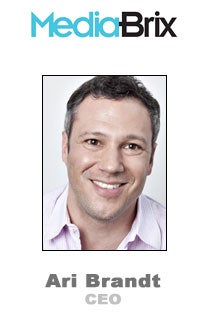 Social media has been both boon and threat to traditional publishers. On one hand, social media has connected publishers to their audience like never before. But the threat has helped drive down CPMs, as the infinite amount of inventory floods the market.
Social media has been both boon and threat to traditional publishers. On one hand, social media has connected publishers to their audience like never before. But the threat has helped drive down CPMs, as the infinite amount of inventory floods the market.
That divide is what social media advertising and analytics provider MediaBrix brought Ari Brandt, the former digital media head for Condé Nast Business Media Group Online, to bridge last year when he was hired as CEO of the company, which was rebranded and repositioned from its previous incarnation, video ad network Smartclip USA. We checked in with Brandt about industry trends, MediaBrix and how he thinks social media and premium advertising can mutually benefit each other.
AdExchanger: What’s your take on all the M&A around social media lately, particularly Oracle’s purchase of Vitrue and Salesforce’s acquisition of Buddy Media? What sort of disciplines do companies need to look for when evaluating a social media marketing independent?
AB: Personally I think the flurry of M&A activity is great! It validates and legitimizes the sector we’re in and the importance of social media marketing to the world’s largest brands. MediaBrix continues focus on the paid and earned side of social media marketing rather than the owned (the “CRM side” of the business) – which was where Buddy and Vitrue have spent most of their time. We’re the only platform that offers brands a suite high-impact in-app video ad solutions (both mobile and web), a dashboard with unified social analytics where we can optimize across product and platform based on a marketers objectives.
As a both a social media marketer and a former publisher, what’s your take on Facebook Exchange? Will this put more pressure on companies to participate in real-time bidding platforms?
Facebook allowing retargeting was a necessary and smart step to introduce a new group of advertisers, a new data set and a new revenue stream to the platform all while protecting Facebook’s own data. I believe there will be a slight lift to performance, but it doesn’t fix the elephant in the room which is providing a larger, more impactful creative palette for brands. Retargeting is a bottom-funnel solution, not awareness or brand building which is where we’re focused.
WPP’s Sir Martin Sorrell has expressed doubts about Facebook as an advertising platform. Are native formats the only solution or can traditional media buying techniques be brought to bear on it?
There have been a lot of posts lately about Facebook and Twitter’s relationships with advertisers and the impact of their native formats. Some say they don’t get advertisers, others say advertisers don’t get them. In reality, the truth is somewhere in between.
For one, I think advertisers do understand the value of native formats on Facebook and Twitter – at least the brands we work with at MediaBrix do. The problem is that it’s hard for brands to achieve and measure their advertising objectives using native ad units.
These large social networks have responded by telling brands that they need to change the way they measure the ROI of these units, which, admittedly, many have started doing. Most brands now keep track of their number of fans , shares, retweets and average engagement per post. But at the end of the day, marketers and their ad agencies are responsible for telling stories selling products.
In order to sell products, you need to tell a compelling story about your product. In order to tell a compelling story, you need a real palette to capture someone’s attention. You just can’t tell a compelling story, not to mention sell a product, with many of the native ad units offered today.
That’s not to say that traditional or intrusive advertising is the way to go on the web. 30 second pre-rolls are basically commercials transplanted over onto a new medium, and they not only perform badly but also infuriate users. Standard IAB units (300 x 250, 728 X 90) is also not the way to go.
What’s the value proposition MediaBrix presents to advertisers?
Everything we continue to focus on at MediaBrix revolves around creating high-impact branding opportunities across social media – web and mobile. We believe there is a creative and analytics void with native formats that can be filled with our suite of solutions.
There has been a massive shift in media consumption — social gaming and online video are two of the largest shifts, so we’ve focused most of our efforts on creating natural, but impactful opportunities targeting one of the most engaged audiences – social gamers. There’s a big disconnect in social advertising right now – marketers know they “need” to be there but most don’t think it works or the current advertising offering address their objectives. That’s where we come in.
So how should brands approach social when it comes to running their ad campaigns?
When thinking about social advertising, marketers should run ads that offer the best user experience in a social environment. For example, Facebook users spend more than 50 percent of their time using apps and playing social games. This means that marketers not running ads where users are most engaged on the social web – in social apps, including games – are missing a huge opportunity.
What sort of tools do you provide to help brands capture those opportunities?
MediaBrix offers brands an impactful way to tell a brand story via in-app social video ads. The best part is that the in-app video ads take user experience into consideration and are only delivered during natural game breaks in social app usage (like after someone has just completed a mission) or in exchange for a valuable in–game reward. Such advertising options perform and are much more likely to engage users, as well as be remembered.
But there is room for a happy medium with the most engaged audience on the web – social gamers. We’ve found that a great way to tell a brand story is to weave it into social gameplay. For example, ads delivered either during natural game breaks (like after someone has just completed a mission) or in exchange for some kind of valuable in–game reward perform well and are much more likely to be remembered and valued by the user.
There are plenty of social advertising solution providers out there (MediaBrix happens to be one) that are experimenting with innovative new ad formats for capturing users attention online. Find the one that works for the story you want to tell and then run with it.
By David Kaplan













